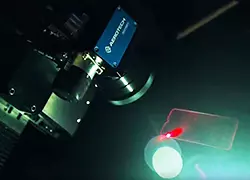Galvo Laser Scan Heads | How They Work and What They Do
Galvo Laser Scan Heads In the world of precision laser material processing, speed and accuracy drive innovation and productivity. The ability to...
Work with our team to determine which products or systems are the best fit for your application.
Some Aerotech products are available for immediate order in North America through our partner Motion Plus.

A case study examining display production that optimizes quality and throughput – and lower total cost.
3 min read
 Bryan Germann
Jun 30, 2025 2:24:19 PM
Bryan Germann
Jun 30, 2025 2:24:19 PM
A galvo laser scan head is the engine of high-speed precision laser material processing. It's a highly sophisticated device that performs a function known as optical beam steering, which is the technology of precisely and rapidly changing the direction of a laser beam. This capability is fundamental to countless industrial laser applications, from marking barcodes on products to cutting intricate patterns in medical devices.
But how does it achieve the incredible speeds and micron-level precision needed for these demanding tasks? The answer lies in its core components and the elegant principle of closed-loop motion control. Understanding how a galvo head works is the key to appreciating its role as an indispensable tool in modern manufacturing.
Understanding how a galvo head works is the key to appreciating its role as an indispensable tool in modern manufacturing.
A galvo head, also known as a galvo scanner or laser scan head, is an opto-mechatronic system designed to steer a laser beam in two dimensions. It consists of two small, lightweight mirrors, each mounted on a high-speed rotary motor called a galvanometer. These motors are engineered for extremely high acceleration and accuracy.
The complete assembly includes the two motors and mirrors, drive electronics and control software. When a laser beam enters the galvo head, it reflects off the first mirror, which controls its position in one axis (e.g., X), and then off the second mirror, which controls its position in the other axis (Y). By precisely coordinating the rotation of both mirrors, the galvo head can direct the laser beam to any point within its processing field. This also answers the basic question, what is a galvo laser? It's a laser system where the beam's path is controlled by this high-speed galvanometer mechanism.
The principle of a galvo scanner is based on high-speed, closed-loop feedback control. It’s not enough for the motors to simply be fast; they must also be incredibly accurate. Here’s how it works:
Command Signal: A controller sends a digital command to the galvo head, telling it where to position the laser spot.
Motor Actuation: The controller’s drive electronics send a current to the galvanometer motors, causing them to rotate the mirrors.
Position Feedback: Attached to each motor is a high-resolution encoder that continuously measures the exact angular position of the mirror. This feedback signal is sent back to the controller in real-time.
Error Correction: The controller compares the actual position (from the encoder) to the commanded position. If there is any difference (an "error"), the controller instantly adjusts the current to the motors to correct the position.
This entire loop of command, move, measure and correct happens thousands of times per second, ensuring the mirrors follow the desired path with extreme fidelity and minimizing any lag or tracking error.
While both are used for beam steering, there are key differences between a fast steering mirror (FSM) and a galvo system. A galvo system uses two separate single-axis motors and mirrors to create 2D motion. This two-mirror design is robust, cost-effective and ideal for a wide range of industrial applications with moderate to large fields of view.
A fast steering mirror, in contrast, is often a single mirror that is moved by multiple actuators (like voice coils) to create both X and Y tilt on a single reflective surface. FSMs are typically used for applications requiring extremely high bandwidth and very small angular deflections, such as free-space optical communication, adaptive optics and image stabilization. For most industrial laser material processing applications, the speed, accuracy and larger angular range of a galvo system make it the superior and more common choice.
A galvo laser can perform an incredible variety of tasks that require the rapid and precise placement of laser energy. Its agility opens up capabilities that would be inefficient or impossible with other motion systems. A galvo laser can:
Mark and Engrave: Quickly create serial numbers, logos and intricate designs on products with high contrast and detail.
Cut Complex Patterns: Trace the outlines of medical stents, flexible circuits and textiles at high speeds.
Drill Micro-Holes: "Trepanning" by moving the beam in a small circle to create precise, high-quality holes for electronics or medical applications.
Weld Delicate Parts: Perform high-speed "wobble" welding to create strong, consistent seams.
Ablate Surfaces: Selectively remove material layer-by-layer for micromachining or surface texturing.
When looking at the many galvo laser scan heads for sale, choosing the best galvo laser scan heads involves matching the device’s performance—such as its speed, thermal stability and control features—to the specific demands of the application.
Galvo Laser Scan Heads In the world of precision laser material processing, speed and accuracy drive innovation and productivity. The ability to...
What is a laser scan head? A laser scan head is a sophisticated device that steers a laser beam with incredible speed and precision. In any advanced...
What Can You Cut with a Galvo Laser Scan Head? Galvanometer (galvo) laser scan heads are renowned for their incredible speed and precision, making...